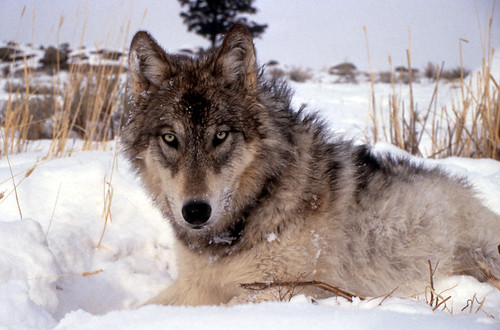going to do I am only going to type about these 3 species of wolves. Gray wolf,Indian wolf and Arctic wolf.
Lets start with the Gray wolf and carry on in that order. By the way I'm sorry I had to keep you waiting but don't take this to heart but I kind of find it funny so, that is why there is a lot of blank.
Gray wolf
To start off the Latin name for the Gray wolf is Canis Lupus, it is native to the snow and wilderness of North America, North Africa and Eurasia. It is known to be the largest member of the wolf family some males weighing from 43-45 kg and females at 36-38.5 kg. As many people know the Gray wolf is literally one
Indian wolf

This one I'll start off differently so, let's start with the appearance and weight the size that sort of stuff. These brown haired small creatures only being 3 ft longways and 66 cm in height up to the shoulder that is, are not surprisingly smaller than the Eurasian wolf. Just like Arabian wolves the fur on these little creatures becomes short and thin in summer still though, the hair on it's back stays long even in summer! Now, in the winter there coat is long but not as long as the Northern subspecies (A lower species of another type of animal e.g. an Indian wolf is the subspecies of a Gray wolf.)
Indian wolves can be recognised different from Arabian wolves because they are bigger and have much larger heads, also they have darker fur. Now I have one big word CANNIBALISM. These wolves sometimes live in places that have pretty much no food so, they are forced to eat each other. I bet your thinking right now urr nasty but it's true. If they have nothing to eat they go ahead and eat each other, sometimes it ends up in a real big fight but they don't care even if they have to at the end sacrifice everything. And, I think that's all the info I got for you guys right now. As you probably know i should have given you the Latin name so here it is: Canis Lupus Pallipes.
Arctic wolf

Well on this one I think I'll go back to the first one again and give you the Latin name first, well it's Canis Lupus Arctos, secondly like the Indian,Bernard's,Mexican Gray, Vancouver island and many more wolves this is a subspecies of the Gray wolf. You can tell which subspecies this is in because of it's Latin name. The Gray wolf and Canis Lupus is just one but there are more maybe I don't know but maybe for other animals too! Arctic wolves live in some of the most harsh places ever this, is where the ground is permanently frozen and the air temperature extremely rarely rises above 30 degrees. These are one of the only animals that can actually survive these severe and harsh conditions. However, all animals and insects including human beings are put here for a reason, you may not think it but even mosquito's who only kill humans to lay their eggs (which is probably what I will be doing next) have a job. Now, I don't want to leave you sitting there trying to figure out what it is so it is to kill humans and live, it is one of the most unusual jobs but just think, if all the humans that died by Malaria were still here imagine how crowded this world would be. Just to leave you thinking on that note I did that. Time to get back to the Arctic Wolf, this creature lives in packs of 6 but sometimes live on their own. They are usually smaller than Gray wolves but I guess it's like that with most sub-species, the legs ears and muzzles are not as big as Gray wolves. They live for about 7 years when in the wild however, when in a zoo/in captivity they live for a whopping 20 years meaning 13 years more! Considering they are carnivores and live in extra badly harsh conditions they have a pretty big diet anyway, this is what they eat: Musk Oxen, Peary Caribou, Arctic foxes (as I explained in the last one they are Cannibals), ptarmigan, Lemmings,Seals, Nesting birds and Arctic Hares.
And if you want to save and adopt a Gray wolf or another type of animal head to the wwf website on your phone or pc. here is the one for the Gray wolf however, on the side where I have my fave wildlife blogs and sites there will be one if you want to adopt another animal.
gifts.worldwildlife.org/gift-center/gifts/Species-Adoptions/Gray-Wolf.aspx?sc=AWY1302WC922

No comments:
Post a Comment
Note: only a member of this blog may post a comment.